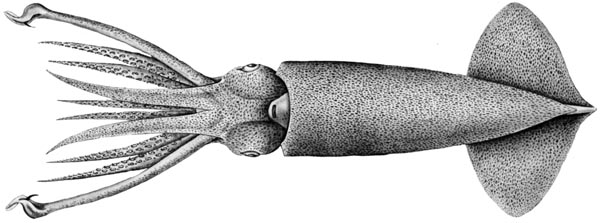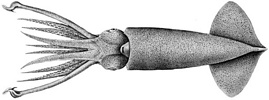Gonatus onyx
Tsunemi Kubodera, F. G. Hochberg, and Richard E. YoungIntroduction
Gonatus onyx is a small and common species of Gonatus. Spent females reach a size of 132-145 mm ML (Seibel, et al., 2000).Diagnosis
A Gonatus with ...
- a single hook on the tentacular club.
- usually less then 10 suckers in the medial zone of the tentacular stalk.
Characteristics
- Arms
- Total of 25-30 hooks and suckers present on proximal half of each arm I-III; squid >40 mm GL with 30-37 suckers on proximal half of each arm IV.
- Total of 25-30 hooks and suckers present on proximal half of each arm I-III; squid >40 mm GL with 30-37 suckers on proximal half of each arm IV.
- Tentacles
- Clubs 20-25% of GL.
- Club dactylus with 5-6 irregular series at proximal end but quickly decreasing to 4 series; over most of dactylus suckers in transverse series approximately equal in size.
- Club ventral-marginal zone with 4 (rarely 5) series of suckers in central part; suckers of medial suckers ca. one-half diameter of suckers of marginal series.
- Club dorsal-marginal zone with 2-3 irregular series dorsal to large central hook.
- Club medial zone with large central hook and proximal series of suckers; proximal suckers never transformed into hooks. Usually no zone member distal to central hook, occasionally large sucker present that may bear a large tooth; rarely a small hook present but usually on just tentacle.
- Total number of suckers (excluding terminal pad and medial zone) on tentacular club: about 160-200.
- Median region of tentacular stalk between marginal series with ca. 0-27 suckers (usually less than 10) scattered suckers.
 image info
image info
 image info
image info
 image info
image info
Figure. Oral view of the tentacle of G. onyx, 69 mm GL. Top - Distal region of tentacle. Middle - Enlargement of club from top figure. Drawings from Young (1972). Bottom - Right tentacular club, paratype, 98 mm ML, female. Photograph by R. Young.
- Head
- Photophores
- Photophores absent
Comments
Life History
Gonatus onyx females brood their young in deep water. Five females have been observed with an ROV carrying large egg masses at depths of 1539 -2522 m in Monterey canyon off California (eastern North Pacific). The black egg mass, with 2000-3000 eggs, is a hollow tube open near the mouth and at the distal end. The gelatinous tube walls consist of double membranes that join together forming a single-layer honeycomb with a single egg in each chamber of the honeycomb. Regular movements of the arms (every 30-40 sec) flush water through the egg mass to aerate the embryos. The black color of the egg mass probably comes from ink released by the female (Seibel et al. 2000; Seibel, et al. 2005).
Water temperatures where the females were observed varied between 1.7 - 3.0°C and at these temperatures the embryos may require as long as 6-9 months to develop. Brooding females lack tentacles, hold onto the egg mass with arm hooks,and apparently don't feed during brooding. High lipid content of the digestive gland and protein in the mantle muscle of the female presumably fuel the metabolism through this long brooding period. Observations of declines in these fuels and female activity with increasing stage of embryonic development support this assumption(Seibel et al. 2000; Seibel, et al. 2005).
Observation of a brooding gonatid in shallow water in the Sea of Okhotsk (Okutani, 1995) combined with the distance required for hatchlings to reach their surface habitat from the brooding sites off California suggests that females transport the egg masses to near-surface waters at the time of hatching (Seibel et al. 2000).
 image info
image info  image info
image info Figure. Left - Ventrolateral view of G. onyx brooding a mass of eggs at a depth of 1539 m in Monterey Canyon off California. ROV photograph from Seibel et al. (2005), © 2002 MBARI. Right top - Frontal and cross-sectional views of pieces of an egg mass of G. onyx. Right bottom - Side view of a hatchling from the egg mass. The club has 70-90 sucker buds. Drawings from Seibel, et al. (2000).
 image info
image info Figure. Laboratory hatchling of G. onyx from a captured egg mass, ca. 3 mm ML. Photograph from Seibel, et al. (2005).
Paralarvae collected in the plankton can be identified by the dorsal-head chromatophore pattern which is Type II-1 [three transverse rows of chromatophores with one chromatophore in the anterior row (this is missing, hence the "-1" attached to "Type II"), two in the middle row and three in the posterior row]; the mantle has one dorsal and four lateral chromatophores (Jorgensen, 2006).
 image info
image infoFigure. Dorsal views of the chromatophores of a G. onyx paralarva, 8.9 mm ML, Gulf of Alaska. Left - Head. Right - Paralarva. Drawing from Jorgensen (2006).
The size of the juvenile at which the various hooks first develop is often distinctive of the species.
 image info
image infoFigure. Chart of the size ranges over which hooks in juveniles of G. onyx first appear. Chart modified from Young (1972).
Distribution
Type locality: 33°19'N, 118°45'W, eastern North Pacific off Southern California. G. onyx is broadly distributed across the North Pacific.
 image info
image infoFigure. Distribution of G. onyx. Dark pink area indicates known range; light pink area indicates inferred range. Chart modified from Okutani, et al. (1988).
References
Jorgensen, E. M. 2006. Identification, distribution and relative abundance of paralarval gonatid squids (Cephalopoda: Oegopsida: Gonatidae)from the Gulf of Alaska, 2001-2003.Journ. Molluscan Studies. In Review.
Okutani, T., T. Kubodera and K. Jefferts. 1983. Diversity, distribution and ecology of gonatid squids in the subarctic Pacific: A review. Bull. Ocean Res. Inst., Univ. Tokyo, No. 26 (1):150-192.
Okutani, T., I. Nakamura and K. Seti. 1995. An unusual egg-brooding behavior of an oceanic squid in the Okhotsk Sea. Venus 54: 237-239.
Seibel, B. A., F. G. Hochberg, and D. B. Carlini. 2000. Life history of Gonatus onyx (Cephalopoda: Teuthoidea): deep-sea spawning and post-spawning egg care. Marine Biology 137 (3): 519-526.
Seibel, B. A., B. H. Robison and S. H. D. Haddock. 2005. Post-spawning egg care by a squid. Nature 438: 929.
Young, R. E. 1972. The systematics and areal distribution of pelagic cephalopods from the seas off Southern California. Smithson. Contr. Zool., 97: 1-159.
Title Illustrations
| Scientific Name | Gonatus onyx |
|---|---|
| Reference | Young, R. E. 1972. The systematics and areal distribution of pelagic cephalopods from the seas off Southern California. Smithson. Contr. Zool., 97: 1-159. |
| View | Ventral |
| Size | 69 mm GL |
| Copyright |
© Richard E. Young

|
About This Page
Tsunemi Kubodera

National Science Museum, Tokyo, Japan
F. G. Hochberg

Santa Barbara Museum of Natural History, Santa Barbara, California, USA
Richard E. Young

University of Hawaii, Honolulu, HI, USA
Page copyright © 2006 , F. G. Hochberg, and Richard E. Young
- First online 31 May 2006
- Content changed 31 May 2006
Citing this page:
Kubodera, Tsunemi, Hochberg, F. G., and Young, Richard E. 2006. Gonatus onyx . Version 31 May 2006. http://tolweb.org/Gonatus_onyx/19769/2006.05.31 in The Tree of Life Web Project, http://tolweb.org










 Go to quick links
Go to quick search
Go to navigation for this section of the ToL site
Go to detailed links for the ToL site
Go to quick links
Go to quick search
Go to navigation for this section of the ToL site
Go to detailed links for the ToL site